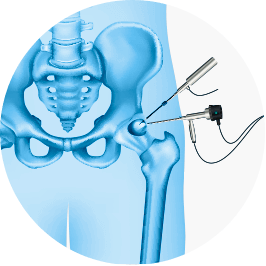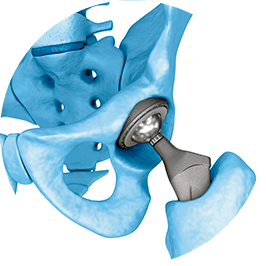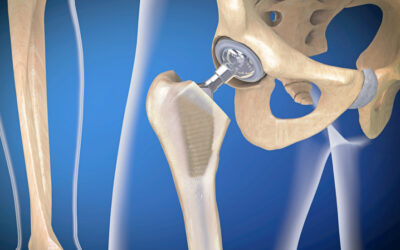Artroplastia de Quadril >
Indicações à Artroplastia Total do Quadril
Em indivíduos mais jovens, o potencial de soltura e osteólise, o risco aumentado de infecção e outras complicações, caso a revisão se torne necessária, devem ser enfatizados.
| Tabela 23.2. Doenças da articulação do quadril com indicação cirúrgica |
|---|
| Artrite Reumatóide, Reumatóide Juvenil (Doença de Still), Espondilite Anquilosante, Lúpus, Doença articular degenerativa (osteoartrose), Primária, Secundária (Deslizamento da cabeça femoral, luxação / displasia congênita do quadril, Doença de Legg-Calvé-Perthes, Doença de Paget, Doença de Gaucher, luxação traumática, fratura do acetábulo, hemofilia). |
| Necrose Avascular (Pós-fratura ou luxação, idiopática, deslizamento da epífise da cabeça femoral, Hemoglobinopatias (Doença falciforme), uso corticóides, álcool, doença de descompressão, fraturas do colo) |
| Doença Renal |
| Artroses tratadas por doenças infecciosas (hematogênica/ piogênica/ osteomielite, pós-operatória, tuberculose) |
| Subluxação ou luxação congênita |
| Artrodese do quadril e pseudoartrose |
| Reconstrução mal-sucedida (Osteotomia, procedimento de Girdlestone …) |
| Tumor ósseo envolvendo o fêmur proximal ou acetábulo |
| Doenças hereditárias (ex: acondroplasia) |
Referências
- Huo MH, Stockton KG, Mont MA, Parvizi J. What’s new in total hip arthroplasty. J Bone Joint Surg Am 2010;92:2959-72.
- Schwartsmann CR, Boschin LC. O quadril adulto. In: Herbert S, Barros Filho TEP, Xavier R, Pardini Jr AG, Eds. Ortopedia e traumatologia: princípios e prática. 4ed. Porto Alegre: Artmed; 2009.
- Instituto Brasileiro de Geografia e Estatística - IBGE. Projeção da população brasileira por sexo e por idade. Disponível na Internet: http://www.ibge.gov.br. 2015.
- Harkess JW, Daniels AU. Introdução e visão geral. In: Canale ST. Cirurgia Ortopédica de Campbell. 10ed. Rio de Janeiro: Manole/ SBOT; 2006. p. 223-42.
- Girdlestone GR. Acute pyogenic arthritis of the hip: an operation giving free access and effective drainage. Lancet 1943;241:419-21.
- Smith-Petersen MN, Larson CB, et al. Complications of old fractures of the neck of the femur: results of treatment of vitallium-mold arthroplasty. J Bone Joint Surg Am 1947;29(1):41-8.
- Harkess JW, Crockarell. Arthroplasty of the hip. In: Canale ST, Beaty JH, Eds. Campbell`s operative orthopaedics. 11th ed. Philadelphia, USA: Mosby/ Elsevier; 2007. p. 314-482.
- Urist MR. The repair of articular surfaces following arthroplasty of the hip. Clin Orthop 1958;12:209-29.
- Ring PA. Five to fourteen year interim results of uncemented total hip arthroplasty. Clin Orthop Relat Res 1978;137:87-95.
- Ring PA. Ring UPM total hip arthroplasty. Clin Orthop Relat Res 1983;176:115-23.
- McKee GK, Watson-Farrar J. Replacement of arthritic hips by the McKee-Farrar prosthesis. J Bone Joint Surg Br 1966;48(2):245-59.
- Charnley J. Arthroplasty of the hip: a new operation. Lancet 1969;1:1129.
- Charnley J. Low friction arthroplasty of the hip: theory and practice. New York: Springer-Verlag; 1979.
- Charnley J. The histology of loosening between acrylic cement and bone. J Bone Joint Surg Br 1975;57(2):245.
- Goldring SR, Schiller AL, Roelke M, Rourke CM, O’Neil DA, Harris WH. The sinovial-like membrane at the bone-cement interface in loose total hip replacements and proposed role in bone lysis. J Bone Joint Surg Am 1983;65(5):575-84.
- Sivash KM. The development of a total metal prosthesis for the hip joint from a partial joint replacement. Reconstr Surg Traumatol 1969;11:53-62.
- Fritsche A, Bialek K, Mittelmeier W, Simnacher M, Fethke K, Wree A, Bader R. Experimental investigations of the insertion and deformation behavior of press-fit and threaded acetabular cups for total hip replacement. J Orthop Sci 2008;13(3):240-7.
- Bobyn JD, Pilliar RM, Cameron HV, Weatherly GC. The optimum pore size for the fixation of porous-surfaced metal implants by the ingrowth of bone. Clin Orthop Relat Res 1980;150:263-70.
- Duffy GP, Berry DJ, Rowland C, Cabanela ME. Primary uncemented total hip arthroplasty in patients <40 years old: 10- to 14-year results using first-generation proximally porous-coated implants. J Arthroplasty 2001;16:140-4.
- Schwartsmann CR, Boschin LC, Gonçalves RZ, Yépez AK, Spinelli LF. New bearing surfaces in total hip replacement. Rev Bras Ortop 2012;47(2):154-9.
- Israel CL. Desenvolvimento de uma máquina para ensaios de desgaste em próteses totais de articulação de quadril. Porto Alegre. Tese [Doutorado em Engenharia Metalúrgica e de Materiais] – UFRGS; 2010.
- Morrey BF, Ilstrup D. Size of the femoral head and acetabular revision in total hip-replacement arthroplasty. J Bone Joint Surg Am 1989;71(1):50-5.
- Charnley J, Halley DK. Rate of wear in total hip replacement. Clin Orthop Relat Res 1975;112:170-9.
- Australian Orthopaedic Association National Joint Replacement Registry. Annual Report. Adelaide: AOA; 2014
- Garellick G, Kärrholm J, Lindahl H, Malchau H, Rogmark C, Rolfson O. Swedish Hip Arthroplasty Register. Annual Report 2013
- National Joint Registry for England, Wales and Northern Ireland. 11th Annual Report 2014. Surgical data to 31 December 2013.
- New Zealand Orthopaedic Association. The New Zealand Joint Registry. Fifteen Year Report. January 1999 to December 2013.
- Chana R, Facek M, Tilley S, Walter WK, Zicat B, Walter WL. Ceramic-on-ceramic bearings in young patients. Outcomes and activity levels at minimum ten-years follow-up. Bone Joint J 2013;95B:1603-9.
- Bartel DL, Burstein AH, Toda MD, Edwards DL. The effect of conformity and plastic thickness on contact stresses in metal-backed plastic implants. J Biomech Eng. 1985;107(3):193-9.
- Cooper HJ, Della Valle CJ. Large diameter femoral heads. Is bigger always better? Bone Joint J 2014;96-B(11 Suppl A):23-6.
- Boutin P, Christel P, Dorlot JM, Meunier A, de Roquancourt A, Blanquaert D, Herman S, Sedel L, Witvoet J. The use of dense alumina-alumina ceramic combination in total hip replacement. J Biomed Mater Res 1988;22(12):1203-32.
- Yoshitomi H, Shikata S, Ito H, Nakayama T, Nakamura T. Manufacturers affect clinical results of THA with zirconia heads: a systematic review. Clin Orthop Relat Res 2009;467(9):2349-55.
- Garbuz DS, Tanzer M, Greidanus NV, Masri BA, Duncan CP. Metal-on-metal hip resurfacing versus large-diameter head metal-on-metal total hip arthroplasty: a randomized clinical trial. Clin Orthop Relat Res 2010;468:318-25.
- Jacobsson SA, Djerf K, Wahlstrom O. A comparative study between McKee-Farrar and Charnley arthroplasty with long-term follow-up periods. J Arthroplasty 1990;5(1):9-14.
- Kothari M, Bartel DL, Brooker JF. Surface geometry of retrieved McKee-Farrar total hip replacements. Clin Orthop Relat Res 1996;329-Suppl:S141-7.
- Berry DJ, Harmsen WS, Cabanela ME, Morrey BF. Twenty-five-year survivorship of two thousand consecutive primary Charnley total hip replacements. J Bone Joint Surg Am 2002;84:171-7.
- Dorr LD, Faugere MC, Mackel AM, Gruen TA, Bognar B, Malluche HH. Structural and cellular assessment of bone quality of proximal femur. Bone 1993;3:231-42.
- Kwon YM, Thomas P, Summer B, Pandit H, Taylor A, Beard D, Murray DW, Gill HS. Lymphocyte proliferation responses in patients with pseudotumors following metal-on-metal hip resurfacing arthroplasty. J Orthop Res 2010;28:444-50.
- Glyn-Jones S, Pandit H, Kwon YM, Doll H, Gill HS, Murray DW. Risk factors for inflammatory pseudotumour formation following hip resurfacing. J Bone Joint Surg Br 2009;91:1566-74.
- Brodner W, Bitzan P, Meisinger V. Elevated serum cobalt with metal on metal articulating surfaces. J Bone Joint Surg 1997;79B:316-21.
- Chapman MW. Chapman`s orthopaedic surgery. 3rd ed. New York: Lippincott Williams & Wilkins; 2001.
- Wroblewski BM, Siney PD, Fleming PA. Charnley low-frictional torque arthroplasty: follow-up for 30 to 40 years. J Bone Joint Surg Br 2009;91(4):447-50.
- Wroblewski BM, Taylor GW, Siney P. Charnley low-friction arthroplasty: 19 to 25 year results. Orthopaedics 1992;15:421-4.
- Halley DK, Charnley J. Results of low friction arthroplasty in patients thirty years of age or younger. Clin Orthop Relat Res 1975;112:180-91.
- Buckwalter AE, Callaghan JJ, Liu SS, Pedersen DR, Goetz DD, Sullivan PM, Leinen JA, Johnston RC. Results of Charnley total hip arthroplasty with use of improved femoral cementing techniques, a concise follow-up, at minimum of twenty-five years, of a previous report. J Bone Joint Surg Am 2006;88(7):1481-5.
- Callaghan JJ, Templeton JE, Liu SS, Pedersen DR, Goetz DD, Sullivan PM, Johnston RC. Results of Charnley total hip arthroplasty at a minimum of thirty years. A concise follow-up of a previous report. J Bone Joint Surg Am 2004;86-A(4):690-5.
3
Ortopedista Especialista em
Quadril em Porto Alegre
![]()
Estrutura Completa
![]()
Especialidades Ortopédicas
![]()
25 anos de atuação

Cirurgias do Quadril

Artroscopia de quadril
A artroscopia de quadril é um procedimento cirúrgico minimamente invasivo realizado através de pequenas incisões, utilizando-se um aparelho chamado artroscópio para visualizar o interior de uma articulação.

Prótese de quadril
O sucesso de uma artroplastia total de quadril depende de 3 fatores críticos: escolha do paciente, escolha do implante e a técnica cirúrgica.
Blog
Palestra no International Society of Hip Arthroscopy
Palestra no International Society of Hip Arthroscopy, 27 – 29 setembro de 2012. Boston/USA
Curso avançado de fratura de pelve e acetábulo em Mendoza, Argentina.
Prótese de quadril ou artroplastia de quadril – História
Embora os tratamentos das afecções do quadril datem de séculos atrás, a era moderna da...
especialista em quadril?



